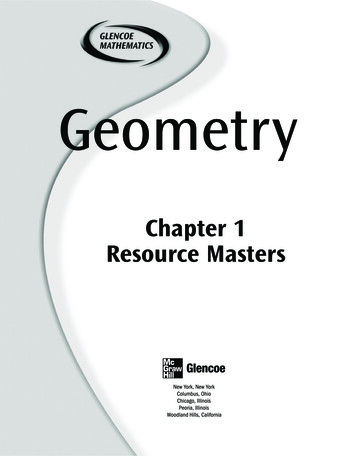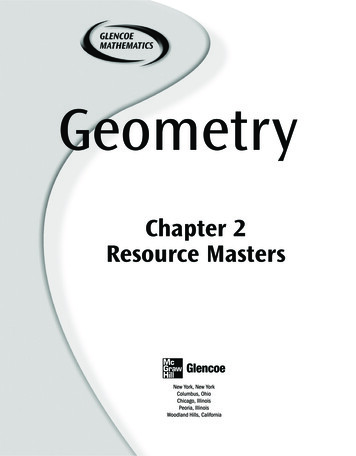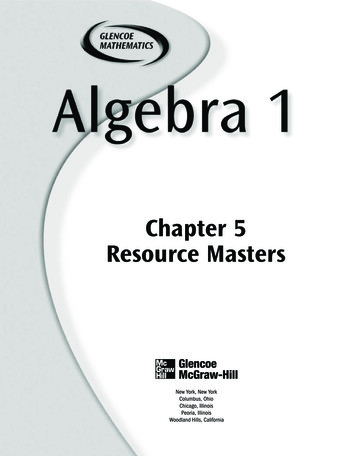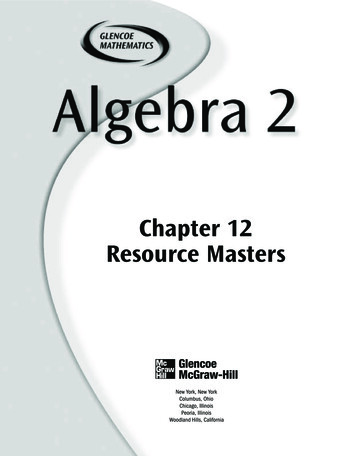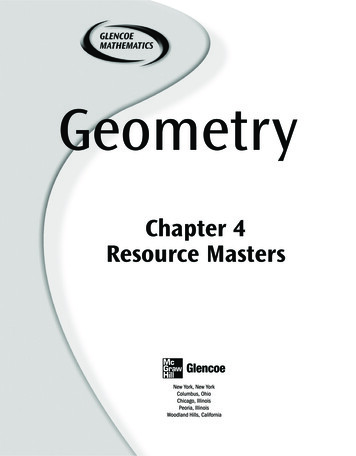
Transcription
GeometryChapter 4Resource Masters
Consumable WorkbooksMany of the worksheets contained in the Chapter Resource Masters bookletsare available as consumable workbooks.Study Guide and Intervention WorkbookSkills Practice WorkbookPractice WorkbookReading to Learn Mathematics 7-861061-3ANSWERS FOR WORKBOOKS The answers for Chapter 4 of these workbookscan be found in the back of this Chapter Resource Masters booklet.Copyright by The McGraw-Hill Companies, Inc. All rights reserved.Printed in the United States of America. Permission is granted to reproduce thematerial contained herein on the condition that such material be reproduced onlyfor classroom use; be provided to students, teachers, and families without charge;and be used solely in conjunction with Glencoe’s Geometry. Any other reproduction,for use or sale, is prohibited without prior written permission of the publisher.Send all inquiries to:The McGraw-Hill Companies8787 Orion PlaceColumbus, OH 43240-4027ISBN: 0-07-860181-91 2 3 4 5 6 7 8 9 10 009 11 10 09 08 07 06 05 04 03GeometryChapter 4 Resource Masters
ContentsVocabulary Builder . . . . . . . . . . . . . . . . viiLesson 4-6Proof Builder . . . . . . . . . . . . . . . . . . . . . . ixStudy Guide and Intervention . . . . . . . . 213–214Skills Practice . . . . . . . . . . . . . . . . . . . . . . . 215Practice . . . . . . . . . . . . . . . . . . . . . . . . . . . 216Reading to Learn Mathematics . . . . . . . . . . 217Enrichment . . . . . . . . . . . . . . . . . . . . . . . . . 218Lesson 4-1Study Guide and Intervention . . . . . . . . 183–184Skills Practice . . . . . . . . . . . . . . . . . . . . . . . 185Practice . . . . . . . . . . . . . . . . . . . . . . . . . . . 186Reading to Learn Mathematics . . . . . . . . . . 187Enrichment . . . . . . . . . . . . . . . . . . . . . . . . . 188Lesson 4-7Study Guide and Intervention . . . . . . . . 219–220Skills Practice . . . . . . . . . . . . . . . . . . . . . . . 221Practice . . . . . . . . . . . . . . . . . . . . . . . . . . . 222Reading to Learn Mathematics . . . . . . . . . . 223Enrichment . . . . . . . . . . . . . . . . . . . . . . . . . 224Lesson 4-2Study Guide and Intervention . . . . . . . . 189–190Skills Practice . . . . . . . . . . . . . . . . . . . . . . . 191Practice . . . . . . . . . . . . . . . . . . . . . . . . . . . 192Reading to Learn Mathematics . . . . . . . . . . 193Enrichment . . . . . . . . . . . . . . . . . . . . . . . . . 194Chapter 4 rLesson 4-3Study Guide and Intervention . . . . . . . . 195–196Skills Practice . . . . . . . . . . . . . . . . . . . . . . . 197Practice . . . . . . . . . . . . . . . . . . . . . . . . . . . 198Reading to Learn Mathematics . . . . . . . . . . 199Enrichment . . . . . . . . . . . . . . . . . . . . . . . . . 200Lesson 4-4Study Guide and Intervention . . . . . . . . 201–202Skills Practice . . . . . . . . . . . . . . . . . . . . . . . 203Practice . . . . . . . . . . . . . . . . . . . . . . . . . . . 204Reading to Learn Mathematics . . . . . . . . . . 205Enrichment . . . . . . . . . . . . . . . . . . . . . . . . . 2064 Test, Form 1 . . . . . . . . . . . . 225–2264 Test, Form 2A . . . . . . . . . . . 227–2284 Test, Form 2B . . . . . . . . . . . 229–2304 Test, Form 2C . . . . . . . . . . . 231–2324 Test, Form 2D . . . . . . . . . . . 233–2344 Test, Form 3 . . . . . . . . . . . . 235–2364 Open-Ended Assessment . . . . . . 2374 Vocabulary Test/Review . . . . . . . 2384 Quizzes 1 & 2 . . . . . . . . . . . . . . . 2394 Quizzes 3 & 4 . . . . . . . . . . . . . . . 2404 Mid-Chapter Test . . . . . . . . . . . . 2414 Cumulative Review . . . . . . . . . . . 2424 Standardized Test Practice . 243–244Standardized Test PracticeStudent Recording Sheet . . . . . . . . . . . . . . A1Lesson 4-5ANSWERS . . . . . . . . . . . . . . . . . . . . . . A2–A32Study Guide and Intervention . . . . . . . . 207–208Skills Practice . . . . . . . . . . . . . . . . . . . . . . . 209Practice . . . . . . . . . . . . . . . . . . . . . . . . . . . 210Reading to Learn Mathematics . . . . . . . . . . 211Enrichment . . . . . . . . . . . . . . . . . . . . . . . . . 212 Glencoe/McGraw-HilliiiGlencoe Geometry
Teacher’s Guide to Using theChapter 4 Resource MastersThe Fast File Chapter Resource system allows you to conveniently file the resourcesyou use most often. The Chapter 4 Resource Masters includes the core materials neededfor Chapter 4. These materials include worksheets, extensions, and assessment options.The answers for these pages appear at the back of this booklet.All of the materials found in this booklet are included for viewing and printing in theGeometry TeacherWorks CD-ROM.Vocabulary BuilderPages vii–viiiinclude a student study tool that presentsup to twenty of the key vocabulary termsfrom the chapter. Students are to recorddefinitions and/or examples for each term.You may suggest that students highlight orstar the terms with which they are notfamiliar.Skills PracticeWHEN TO USE Give these pages toPractice There is one master for eachlesson. These problems more closely followthe structure of the Practice and Applysection of the Student Edition exercises.These exercises are of average difficulty.There is one master foreach lesson. These provide computationalpractice at a basic level.WHEN TO USE These masters can beused with students who have weakermathematics backgrounds or needadditional reinforcement.students before beginning Lesson 4-1.Encourage them to add these pages to theirGeometry Study Notebook. Remind them toadd definitions and examples as theycomplete each lesson.WHEN TO USE These provide additionalpractice options or may be used ashomework for second day teaching of thelesson.Vocabulary BuilderPages ix–xinclude another student study tool thatpresents up to fourteen of the key theoremsand postulates from the chapter. Studentsare to write each theorem or postulate intheir own words, including illustrations ifthey choose to do so. You may suggest thatstudents highlight or star the theorems orpostulates with which they are not familiar.Reading to Learn MathematicsOne master is included for each lesson. Thefirst section of each master asks questionsabout the opening paragraph of the lessonin the Student Edition. Additionalquestions ask students to interpret thecontext of and relationships among termsin the lesson. Finally, students are asked tosummarize what they have learned usingvarious representation techniques.WHEN TO USE Give these pages tostudents before beginning Lesson 4-1.Encourage them to add these pages to theirGeometry Study Notebook. Remind them toupdate it as they complete each lesson.WHEN TO USE This master can be usedas a study tool when presenting the lessonor as an informal reading assessment afterpresenting the lesson. It is also a helpfultool for ELL (English Language Learner)students.Study Guide and InterventionEach lesson in Geometry addresses twoobjectives. There is one Study Guide andIntervention master for each objective.WHEN TO USE Use these masters asreteaching activities for students who needadditional reinforcement. These pages canalso be used in conjunction with the StudentEdition as an instructional tool for studentswho have been absent. Glencoe/McGraw-HillivGlencoe Geometry
A Vocabulary Test, suitable for allstudents, includes a list of the vocabularywords in the chapter and ten questionsassessing students’ knowledge of thoseterms. This can also be used in conjunction with one of the chapter tests or as areview worksheet.EnrichmentThere is one extensionmaster for each lesson. These activities mayextend the concepts in the lesson, offer anhistorical or multicultural look at theconcepts, or widen students’ perspectives onthe mathematics they are learning. Theseare not written exclusively for honorsstudents, but are accessible for use with alllevels of students.Intermediate Assessment Four free-response quizzes are includedto offer assessment at appropriateintervals in the chapter.WHEN TO USE These may be used asextra credit, short-term projects, or asactivities for days when class periods areshortened. A Mid-Chapter Test provides an optionto assess the first half of the chapter. It iscomposed of both multiple-choice andfree-response questions.Assessment OptionsThe assessment masters in the Chapter 4Resources Masters offer a wide range ofassessment tools for intermediate and finalassessment. The following lists describe eachassessment master and its intended use.Continuing Assessment The Cumulative Review providesstudents an opportunity to reinforce andretain skills as they proceed throughtheir study of Geometry. It can also beused as a test. This master includesfree-response questions.Chapter AssessmentCHAPTER TESTS The Standardized Test Practice offerscontinuing review of geometry conceptsin various formats, which may appear onthe standardized tests that they mayencounter. This practice includes multiplechoice, grid-in, and short-responsequestions. Bubble-in and grid-in answersections are provided on the master. Form 1 contains multiple-choice questionsand is intended for use with basic levelstudents. Forms 2A and 2B contain multiple-choicequestions aimed at the average levelstudent. These tests are similar in formatto offer comparable testing situations. Forms 2C and 2D are composed of freeresponse questions aimed at the averagelevel student. These tests are similar informat to offer comparable testingsituations. Grids with axes are providedfor questions assessing graphing skills.Answers Page A1 is an answer sheet for theStandardized Test Practice questionsthat appear in the Student Edition onpages 232–233. This improves students’familiarity with the answer formats theymay encounter in test taking. Form 3 is an advanced level test withfree-response questions. Grids withoutaxes are provided for questions assessinggraphing skills. The answers for the lesson-by-lessonmasters are provided as reduced pageswith answers appearing in red.All of the above tests include a freeresponse Bonus question. Full-size answer keys are provided forthe assessment masters in this booklet. The Open-Ended Assessment includesperformance assessment tasks that aresuitable for all students. A scoring rubricis included for evaluation guidelines.Sample answers are provided forassessment. Glencoe/McGraw-HillvGlencoe Geometry
NAME DATE4PERIODReading to Learn MathematicsThis is an alphabetical list of the key vocabulary terms you will learn in Chapter 4.As you study the chapter, complete each term’s definition or description. Rememberto add the page number where you found the term. Add these pages to yourGeometry Study Notebook to review vocabulary at the end of the chapter.Vocabulary TermFoundon PageDefinition/Description/Exampleacute trianglebase angles congruence transformationkuhn·GROO·uhnscongruent trianglescoordinate proofcorollaryequiangular triangleequilateral triangleexterior angle(continued on the next page) Glencoe/McGraw-HillviiGlencoe GeometryVocabulary BuilderVocabulary Builder
NAME DATE4PERIODReading to Learn MathematicsVocabulary BuilderVocabulary Term(continued)Foundon PageDefinition/Description/Exampleflow proofincluded angleincluded sideisosceles triangleobtuse triangleremote interior anglesright triangle scalene triangleSKAY·leenvertex angle Glencoe/McGraw-HillviiiGlencoe Geometry
NAME DATE4PERIODLearning to Read MathematicsThis is a list of key theorems and postulates you will learn in Chapter 4. As youstudy the chapter, write each theorem or postulate in your own words. Includeillustrations as appropriate. Remember to include the page number where youfound the theorem or postulate. Add this page to your Geometry Study Notebookso you can review the theorems and postulates at the end of the chapter.Theorem or PostulateFoundon PageDescription/Illustration/AbbreviationTheorem 4.1Angle Sum TheoremTheorem 4.2Third Angle TheoremTheorem 4.3Exterior Angle TheoremTheorem 4.4Theorem 4.5Angle-Angle-SideCongruence (AAS)Theorem 4.6Leg-Leg Congruence (LL)Theorem 4.7Hypotenuse-AngleCongruence (HA)(continued on the next page) Glencoe/McGraw-HillixGlencoe GeometryProof BuilderProof Builder
NAME DATE4PERIODLearning to Read MathematicsProof BuilderTheorem or Postulate(continued)Foundon PageDescription/Illustration/AbbreviationTheorem 4.8Leg-Angle Congruence (LA)Theorem 4.9Isosceles Triangle TheoremTheorem 4.10Postulate 4.1Side-Side-Side Congruence(SSS)Postulate 4.2Side-Angle-Side Congruence(SAS)Postulate 4.3Angle-Side-AngleCongruence (ASA)Postulate 3.4Hypotenuse-Leg Congruence(HL) Glencoe/McGraw-HillxGlencoe Geometry
NAME DATE4-1PERIODStudy Guide and InterventionClassifying TrianglesClassify Triangles by AnglesOne way to classify a triangle is by the measuresof its angles. If one of the angles of a triangle is an obtuse angle, then the triangle is an obtuse triangle. If one of the angles of a triangle is a right angle, then the triangle is a right triangle. If all three of the angles of a triangle are acute angles, then the triangle is an acute triangle.Examplea.Lesson 4-1 If all three angles of an acute triangle are congruent, then the triangle is an equiangular triangle.Classify each triangle.AB60 CAll three angles are congruent, so all three angles have measure 60 .The triangle is an equiangular triangle.b.E120 35 D25 FThe triangle has one angle that is obtuse. It is an obtuse triangle.c.G90 H60 30 JThe triangle has one right angle. It is a right triangle.ExercisesClassify each triangle as acute, equiangular, obtuse, or right.1. K2. N30 67 L4.23 3.Q65 65 60 PMR5. W60 60 VGlencoe/McGraw-HillXS6.B60 45 50 O120 90 TU30 90 45 Y183F28 92 DGlencoe Geometry
NAME DATE4-1PERIODStudy Guide and Intervention(continued)Classifying TrianglesClassify Triangles by Sides You can classify a triangle by the measures of its sides.Equal numbers of hash marks indicate congruent sides. If all three sides of a triangle are congruent, then the triangle is an equilateral triangle. If at least two sides of a triangle are congruent, then the triangle is an isosceles triangle. If no two sides of a triangle are congruent, then the triangle is a scalene triangle.Examplea.Classify each triangle.b.Hc.NT23LRJTwo sides are congruent.The triangle is anisosceles triangle.XPAll three sides arecongruent. The triangleis an equilateral triangle.12V15The triangle has no pairof congruent sides. It isa scalene triangle.ExercisesClassify each triangle as equilateral, isosceles, or scalene.1.A2G4. 32.1C18K5. BS3.G18W171218QIA32xO196. D32x8xCMxxExFU7. Find the measure of each side of equilateral RST with RS 2x 2, ST 3x,and TR 5x 4.8. Find the measure of each side of isosceles ABC with AB BC if AB 4y,BC 3y 2, and AC 3y.9. Find the measure of each side of ABC with vertices A( 1, 5), B(6, 1), and C(2, 6).Classify the triangle. Glencoe/McGraw-Hill184Glencoe Geometry
NAME DATE4-1PERIODSkills PracticeClassifying Triangles1.2.3.4.5.6.Identify the indicated type of triangles.7. rightBA8. isoscelesE9. scaleneLesson 4-1Use a protractor to classify each triangle as acute, equiangular, obtuse, or right.DC10. obtuseALGEBRA Find x and the measure of each side of the triangle.11. ABC is equilateral with AB 3x 2, BC 2x 4, and CA x 10.12. DEF is isosceles, D is the vertex angle, DE x 7, DF 3x 1, and EF 2x 5.Find the measures of the sides of RST and classify each triangle by its sides.13. R(0, 2), S(2, 5), T(4, 2)14. R(1, 3), S(4, 7), T(5, 4) Glencoe/McGraw-Hill185Glencoe Geometry
NAME DATE4-1PERIODPracticeClassifying TrianglesUse a protractor to classify each triangle as acute, equiangular, obtuse, or right.1.2.3.Identify the indicated type of triangles if BA A D B D D C , B E E D , A B B C , and E D D C .4. rightBE5. obtuseA6. scaleneDC7. isoscelesALGEBRA Find x and the measure of each side of the triangle.8. FGH is equilateral with FG x 5, GH 3x 9, and FH 2x 2.9. LMN is isosceles, L is the vertex angle, LM 3x 2, LN 2x 1, and MN 5x 2.Find the measures of the sides of KPL and classify each triangle by its sides.10. K( 3, 2) P(2, 1), L( 2, 3)11. K(5, 3), P(3, 4), L( 1, 1)12. K( 2, 6), P( 4, 0), L(3, 1)13. DESIGN Diana entered the design at the right in a logo contestsponsored by a wildlife environmental group. Use a protractor.How many right angles are there? Glencoe/McGraw-Hill186Glencoe Geometry
NAME DATE4-1PERIODReading to Learn MathematicsClassifying TrianglesPre-ActivityWhy are triangles important in construction?Read the introduction to Lesson 4-1 at the top of page 178 in your textbook. Why are triangles used for braces in construction rather than other shapes?Reading the Lesson1. Supply the correct numbers to complete each sentence.a. In an obtuse triangle, there areacute angle(s),right angle(s), andobtuse angle(s).b. In an acute triangle, there areacute angle(s),right angle(s), andobtuse angle(s).c. In a right triangle, there areacute angle(s),right angle(s), andobtuse angle(s).2. Determine whether each statement is always, sometimes, or never true.a. A right triangle is scalene.b. An obtuse triangle is isosceles.c. An equilateral triangle is a right triangle.d. An equilateral triangle is isosceles.e. An acute triangle is isosceles.f. A scalene triangle is obtuse.3. Describe each triangle by as many of the following words as apply: acute, obtuse, right,scalene, isosceles, or equilateral.a.b.70 80 30 c.135 435Helping You Remember4. A good way to remember a new mathematical term is to relate it to a nonmathematicaldefinition of the same word. How is the use of the word acute, when used to describeacute pain, related to the use of the word acute when used to describe an acute angle oran acute triangle? Glencoe/McGraw-Hill187Glencoe GeometryLesson 4-1 Why do you think that isosceles triangles are used more often thanscalene triangles in construction?
NAME DATE4-1PERIODEnrichmentReading MathematicsWhen you read geometry, you may need to draw a diagram to make the texteasier to understand.ExampleConsider three points, A, B, and C on a coordinate grid.The y-coordinates of A and B are the same. The x-coordinate of B isgreater than the x-coordinate of A. Both coordinates of C are greaterthan the corresponding coordinates of B. Is triangle ABC acute, right,or obtuse?To answer this question, first draw a sample trianglethat fits the description.Side AB must be a horizontal segment because they-coordinates are the same. Point C must be locatedto the right and up from point B.From the diagram you can see that triangle ABCmust be obtuse.yQABOxAnswer each question. Draw a simple triangle on the grid above to help you. 1. Consider three points, R, S, andT on a coordinate grid. Thex-coordinates of R and S are thesame. The y-coordinate of T isbetween the y-coordinates of Rand S. The x-coordinate of T is lessthan the x-coordinate of R. Is angleR of triangle RST acute, right, orobtuse?2. Consider three noncollinear points,J, K, and L on a coordinate grid. They-coordinates of J and K are thesame. The x-coordinates of K and Lare the same. Is triangle JKL acute,right, or obtuse?3. Consider three noncollinear points,D, E, and F on a coordinate grid.The x-coordinates of D and E areopposites. The y-coordinates of D andE are the same. The x-coordinate ofF is 0. What kind of triangle must DEF be: scalene, isosceles, orequilateral?4. Consider three points, G, H, and Ion a coordinate grid. Points G andH are on the positive y-axis, andthe y-coordinate of G is twice they-coordinate of H. Point I is on thepositive x-axis, and the x-coordinateof I is greater than the y-coordinateof G. Is triangle GHI scalene,isosceles, or equilateral?Glencoe/McGraw-Hill188Glencoe Geometry
NAME DATE4-2PERIODStudy Guide and InterventionAngles of TrianglesAngle Sum Theorem If the measures of two angles of a triangle are known,the measure of the third angle can always be found.Angle SumTheoremThe sum of the measures of the angles of a triangle is 180.In the figure at the right, m A m B m C 180.BAExample 1Example 2Find the missingangle measures.Find m T.SB35 90 Tm R m S m T 18025 35 m T 18060 m T 180m T 120A58 C12Angle SumTheoremSubstitutionAdd.Subtract 60from each side.D3108 Em 1 m A m Bm 1 58 90m 1 148m 1 18018018032m 2 32m 3 m 2 m Em 3 32 108m 3 140m 3 18018018040Angle Sum TheoremSubstitutionAdd.Subtract 148 fromeach side.Vertical angles arecongruent.Angle Sum TheoremSubstitutionAdd.Subtract 140 fromeach side.ExercisesFind the measure of each numbered angle.1.2.MS62 90 1P13. VW5.R4. M60 U30 QN130 366 1T58 2QN250 OP6. AR20 1 2152 T 60 W 30 Glencoe/McGraw-HillGS1891DGlencoe GeometryLesson 4-225 RC
NAME DATE4-2PERIODStudy Guide and Intervention(continued)Angles of TrianglesExterior Angle TheoremAt each vertex of a triangle, the angle formed by one sideand an extension of the other side is called an exterior angle of the triangle. For eachexterior angle of a triangle, the remote interior angles are the interior angles that are notadjacent to that exterior angle. In the diagram below, B and A are the remote interiorangles for exterior DCB.The measure of an exterior angle of a triangle is equal tothe sum of the measures of the two remote interior angles.m 1 m A m BExterior AngleTheoremB1CDExample 1Example 2Find m 1.Find x.PS78 Q80 RA160 Tx Sm 1 m R m S 60 80 140Exterior Angle TheoremSubstitutionAdd.55 Rm PQS m R m S78 55 x23 xExterior Angle TheoremSubstitutionSubtract 55 from each side.ExercisesFind the measure of each numbered angle.1.2.XA35 50 Y165 3.CWN1M4.80 QOV1P3235 2UDSR60 60 32 125 BZ36 TFind x.5.6. EA95 B 2x Glencoe/McGraw-Hillx 145 Cx 58 DH190GFGlencoe Geometry
NAME DATE4-2PERIODSkills PracticeAngles of TrianglesFind the missing angle measures.1.80 2.146 STIGER73 Find the measure of each angle.85 55 13. m 1240 34. m 2Find the measure of each angle.36. m 12155 150 70 7. m 28. m 3Find the measure of each angle.9. m 140 80 160 4105 210. m 25311. m 312. m 413. m 5Find the measure of each angle.B114. m 115. m 2 Glencoe/McGraw-HillA1912D63 CGlencoe GeometryLesson 4-25. m 3
NAME DATE4-2PERIODPracticeAngles of TrianglesFind the missing angle measures.1.2.72 ?40 55 Find the measure of each angle.358 3. m 11235 4. m 239 5. m 3Find the measure of each angle.526. m 1317. m 470 36 68 118 6465 82 8. m 39. m 210. m 511. m 6Find the measure of each angle if BAD and BDC are right angles and m ABC 84.B12. m 1A164 C2D13. m 214. CONSTRUCTION The diagram shows anexample of the Pratt Truss used in bridgeconstruction. Use the diagram to find m 1. Glencoe/McGraw-Hill1921145 Glencoe Geometry
NAME DATE4-2PERIODReading to Learn MathematicsAngles of TrianglesPre-ActivityHow are the angles of triangles used to make kites?Read the introduction to Lesson 4-2 at the top of page 185 in your textbook.The frame of the simplest kind of kite divides the kite into four triangles.Describe these four triangles and how they are related to each other.Reading the Lesson1. Refer to the figure.EAa. Name the three interior angles of the triangle. (Use threeletters to name each angle.)DBb. Name three exterior angles of the triangle. (Use three lettersto name each angle.)23 c. Name the remote interior angles of EAB.CFd. Find the measure of each angle without using a protractor.i. DBCii. ABCiii. ACFiv. EAB2. Indicate whether each statement is true or false. If the statement is false, replace theunderlined word or number with a word or number that will make the statement true.a. The acute angles of a right triangle are supplementary.b. The sum of the measures of the angles of any triangle is 100.c. A triangle can have at most one right angle or acute angle.d. If two angles of one triangle are congruent to two angles of another triangle, then thethird angles of the triangles are congruent.e. The measure of an exterior angle of a triangle is equal to the difference of themeasures of the two remote interior angles.f. If the measures of two angles of a triangle are 62 and 93, then the measure of thethird angle is 35.g. An exterior angle of a triangle forms a linear pair with an interior angle of thetriangle.Helping You Remember3. Many students remember mathematical ideas and facts more easily if they see themdemonstrated visually rather than having them stated in words. Describe a visual wayto demonstrate the Angle Sum Theorem. Glencoe/McGraw-Hill193Glencoe GeometryLesson 4-239
NAME DATE4-2PERIODEnrichmentFinding Angle Measures in TrianglesYou can use algebra to solve problems involving triangles.ExampleIn triangle ABC, m A, is twice m B, and m Cis 8 more than m B. What is the measure of each angle?Write and solve an equation. Let x m B.m A m B m C 1802x x (x 8) 1804x 8 1804x 172x 43So, m A 2(43) or 86, m B 43, and m C 43 8 or 51.Solve each problem.1. In triangle DEF, m E is three timesm D, and m F is 9 less than m E.What is the measure of each angle?2. In triangle RST, m T is 5 more thanm R, and m S is 10 less than m T.What is the measure of each angle?3. In triangle JKL, m K is four timesm J, and m L is five times m J.What is the measure of each angle?4. In triangle XYZ, m Z is 2 more than twicem X, and m Y is 7 less than twice m X.What is the measure of each angle?5. In triangle GHI, m H is 20 more thanm G, and m G is 8 more than m I.What is the measure of each angle?6. In triangle MNO, m M is equal to m N,and m O is 5 more than three timesm N. What is the measure of each angle?7. In triangle STU, m U is half m T,and m S is 30 more than m T. Whatis the measure of each angle?8. In triangle PQR, m P is equal tom Q, and m R is 24 less than m P.What is the measure of each angle?9. Write your own problems about measures of triangles. Glencoe/McGraw-Hill194Glencoe Geometry
NAME DATE4-3PERIODStudy Guide and InterventionCongruent TrianglesCorresponding Parts of Congruent TrianglesSBTriangles that have the same size and same shape arecongruent triangles. Two triangles are congruent if andonly if all three pairs of corresponding angles are congruentand all three pairs of corresponding sides are congruent. Inthe figure, ABC RST.RTCAExampleIf XYZ RST, name the pairs ofcongruent angles and congruent sides. X R, Y S, Z TX Y R S , X Z R T , Y Z S T YSXRZTExercisesIdentify the congruent triangles in each figure.1.2.KBD3. KLJMJALACCName the corresponding congruent angles and sides for the congruent triangles.4. FG LK5. B6. RDUE Glencoe/McGraw-HillJAC195STGlencoe GeometryLesson 4-3B
NAME DATE4-3PERIODStudy Guide and Intervention(continued)Congruent TrianglesIdentify Congruence TransformationsIf two triangles are congruent, you canslide, flip, or turn one of the triangles and they will still be congruent. These are calledcongruence transformations because they do not change the size or shape of the figure.It is common to use prime symbols to distinguish between an original ABC and atransformed A B C .ExampleName the congruence transformationthat produces A B C from ABC.The congruence transformation is a slide. A A ; B B ; C C ; BA A B ; A C A C ; B C B C yBB OAxCA C ExercisesDescribe the congruence transformation between the two triangles as a slide, aflip, or a turn. Then name the congruent triangles.1.2.S yyNTPORxT S 3.MN yOxP M 4.PyAQCOxOQ 5.P 6.yC xB BCyNPMxOA B P A xOGlencoe/McGraw-HillN B196Glencoe Geometry
NAME DATE4-3PERIODSkills PracticeCongruent TrianglesIdentify the congruent triangles in each figure.1.2.VPBAXTJLYS3.W4.QRPCEFDSGName the congruent angles and sides for each pair of congruent triangles.6. PQR STUVerify that each of the following transformations preserves congruence, and namethe congruence transformation.7. ABC A B C 8. DEF D E F yB E xOA AyEB C DCGlencoe/McGraw-HillF F O197D xGlencoe GeometryLesson 4-35. ABC FGH
NAME DATE4-3PERIODPracticeCongruent TrianglesIdentify the congruent triangles in each figure.1.2.BMPNRACSQLDName the congruent angles and sides for each pair of congruent triangles.3. GKP LMN4. ANC RBVVerify that each of the following transformations preserves congruence, and namethe congruence transformation.5. PST P S T 6. LMN L M N yS SOPyMT T LNOxL P xN M QUILTING For Exercises 7 and 8, refer to the quilt design.ACDEGF7. Indicate the triangles that appear to be congruent.B8. Name the congruent angles and congruent sides of a pair ofcongruent triangles. Glencoe/McGraw-Hill198IHGlencoe Geometry
NAME DATE4-3PERIODReading to Learn MathematicsCongruent TrianglesPre-ActivityWhy are triangles used in bridges?Read the introduction to Lesson 4-3 at the top of page 192 in your textbook.In the bridge shown in the photograph in your textbook, diagonal braceswere used to divide squares into two isosceles right triangles. Why do youthink th
Glencoe/McGraw-Hill iv Glencoe Geometry Teacher’s Guide to Using the Chapter 4 Resource Masters The Fast FileChapter Resource system allows you to conveniently file the resources you use most often. The Chapter 4 Resource Mastersincludes the core materials needed for Chapter 4. These material




